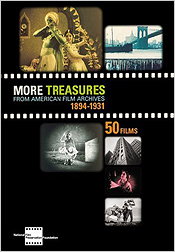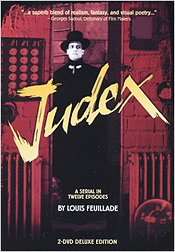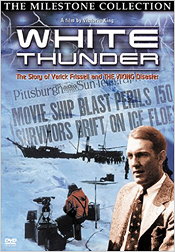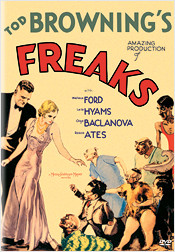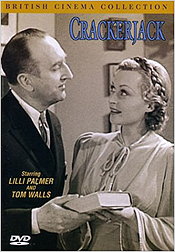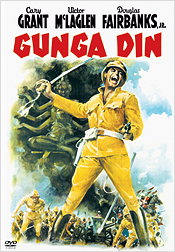 |
Site created 12/15/97.

page created: 1/10/05
 Barrie Maxwell - Main Page |
|
| Classic
Reviews Roundup #14 - January 2005 I've attempted to clear my shelves of pending screeners in order to get ready for the 2005 releases. Hence, I offer a healthy serving of 27 disc reviews for your pleasure, ranging from a silent serial to B western collections, major Hollywood Golden Age treasures, and documentaries both old and new. As usual, the reviews are ordered by year of the content's original release. More Treasures from American Film Archives (1894-1931) (released on DVD by Image on September 7th, 2004) Four years ago, one of the DVD box sets vying for best of the year was Treasures from American Film Archives, an ambitious four-disc and one book collection distributed by Image that contained 50 films preserved by the likes of George Eastman House, the Library of Congress, the Museum of Modern Art, and the UCLA Film and Television Archive among others. The selections spanned the years 1893 to 1985 and included features from the silent era, documentaries and newsreels, one-reel adventures and comedies, experimental animation, home movies, and much more. |
|
| Disc
One Dickson Experimental Sound Film (ca. 1894), Buffalo Bill's Wild West (Annie Oakley [1894], Buffalo Dance [1894], Bucking Broncho [1894]), The Suburbanite (1904), The Country Doctor (1909), The Wonderful Wizard of Oz (1910), Early Advertising Films (Admiral Cigarette [1897], Flash Cleaner [ca. 1920], Buy an Electric Refrigerator [1926], The Stenographer's Friend [1910]), The Invaders (1912), The Hazards of Helen: Episode 26 - The Wild Engine (1915), Gretchen the Greenhorn (1916), De-Light: Making an Electric Light Bulb (1920), Skyscraper Symphony (1929), Greeting by George Bernard Shaw (1928) Disc Two The Streets of New York (What Happened on Twenty-Third Street, New York City [1901], At the Foot of the Flatiron [1903], New York City "Ghetto' Fish Market [1903]), From Leadville to Aspen: A Hold-Up in the Rockies (1906), The "Teddy" Bears (1907), Children Who Labor (1912), Early Colour Films (From Concerning $1000 [1916], From Exhibition Reel of Two Color Film [ca. 1929], The Flute of Krishna [1926]), Surviving reel of Lotus Blossom (1921), Gus Visser and His Singing Duck (ca. 1925), Clash of the Wolves (1925), International Newsreel, Volume 8, Issue 97 (1926), Now You're Talking (1927), There It Is (1928), A Bronx Morning (1931) Disc Three Rip Van Winkle (1896), Mr. Edison at Work in His Chemical Laboratory (1897), Life of An American Fireman (1903), Three films from the Westinghouse Works series (1904), Falling Leaves (1912), Hollywood Promotional Films (Exhibitors' reel for Hands Up [1918], From C-V News, Filming Greed in Death Valley [1923], Movie Lovers Contest #4 [1926]), De Forest Phonofilms (A Few Moments with Eddie Cantor [ca. 1923], President Coolidge, Taken on the White House Grounds [1924]), Inklings, Issue 12 (1925), Lady Windermere's Fan (1925), Cockeyed: Gems from the Memory of a Nutty Cameraman (ca. 1925), "The Prologue" from The Passaic Textile Strike (1926), Tramp, Tramp, Tramp (1926), From Zora Neale Hurston's Fieldwork Footage (1928), Trailers for Lost Films (In the Days of Daniel Boone [1923], The Silent Flyer [1926], The American Venus [1926], The Great Gatsby [1926], Beau Sabreur [1928], The Patriot [1928]) There are the inevitable signs of deterioration and age on much of this material, but most items look quite amazing nonetheless. All are apparently properly framed and include original tints and colours where possible. The documentation with each item is amazing including audio commentaries by critics, historians, or archivists and written information on each item's content and accompanying music (both as screen text and in the supporting book included in the box set). Net proceeds from the sale of the sets will go to support further film preservation. Highly recommended. Judex (1916-1917) (released on DVD by Flicker Alley on June 4th, 2004) Those familiar with American sound serials are quite used to the standard cliffhanger ending that concluded each chapter. This was also characteristic of most American silent serials and the norm for them by the early 1920s. The silent serial was not unique to Hollywood, however. In France, director Louis Feuillade worked extensively with the format in the second decade of the 20th century. His first serial was Fantômas (1913-1914), an enormously popular tale about a criminal mastermind who is eventually brought to justice. Feuillade followed this up with a second serial about rival criminal gangs in Paris entitled Les Vampires (1915-1916). Even at 10 chapters totaling some seven hours of playing time, it proved to be another great success. Les Vampires has some familiarity for modern North American audiences because of its recent showings on TCM and availability on DVD through Image. These French serials differed from their American counterparts in that the individual chapters did not end with cliffhangers and generally had much longer playing times. Feuillade's third serial was Judex (1916-1917), a 12-chapter effort over five hours in length. |
|
| Judex
is the second DVD release from a fairly new company, Flicker Alley.
(Its previous one was a fine presentation of the fascinating 1928
film, The Garden of Eden.)
Judex is presented on two
discs and sports a nice tinted transfer. There are numerous speckles
and scratches, but the full frame image otherwise looks very bright
and detailed for the most part. There are occasional blooming of
whites and some instances of softness, but overall the impression is
of a product of unusually good image quality for a film of such a
vintage. The serial sports a new piano and orchestral musical score
by Robert Israel that fits the mood and origin of the material very
well. It offers a nice clean sound characterized by modest surround
effects. The disc supplements include an informative booklet essay
by film historian Jan-Christopher Horak and a good 18-minute
featurette in which composer Israel discusses the creation of his
new music score. Recommended. The Viking/White Thunder (1931/2002) (released on DVD by Milestone on December 14th, 2004) It's a real pleasure to report on a DVD release from Milestone that packages a fascinating recent documentary on a little-remembered event in early film-making and the original film that inspired it. In the 1920s, Varick Frissell, the son of a well-off New York family, became intrigued by Canada's near-north region of Labrador, nearby Newfoundland, and the adjacent, ice-covered North Atlantic waters. He found himself documenting many of the region's natural wonders and the life of its peoples, and becoming involved with Dr. Wilfred Grenfell, the famous physician who devoted so many years of his life to Labrador. Frissell became very interested in the North Atlantic seal hunt and the Newfoundlanders of whose life it was an integral part and made it his life's goal to produce a film about it. He managed to interest Paramount in a distribution deal that allowed him to raise the necessary financing. In order to make his film (to be called White Thunder) a commercial success, Paramount insisted on a melodramatic background story that would star Charles Starrett. Also prominently featured would be real-life sealing-ship captain Bob Bartlett. In 1930, Frissell and the cast and crew carried out the principal photography on location in Newfoundland and on the actual ice floes using the sealing ship Viking as a base, but found it necessary to return in early 1931 for additional footage. During that trip, an explosion aboard the Viking resulted in the death of Frissell and many others - one of Hollywood's worst film-making disasters. Subsequently, Paramount released the completed film in 1931 as The Viking with a prologue by Wilfred Grenfell. Seventy-one years later, the events surrounding Frissell's early life and the making of The Viking were documented in a National Film Board of Canada production directed by Victoria King and entitled White Thunder. |
|
| On
Milestone's DVD, the modern White Thunder
documentary looks predictably good. The new footage is crisp and
colourful, but even the vintage footage shows very good detail
despite significant age-related deterioration . The mono sound is
clear. The original The Viking
is in remarkably good shape. The expected age-related speckling,
scratches, and debris are present, but the image offers good detail,
reasonable sharpness, and only occasional lapses in contrast. The
mono sound has background hiss, but is quite adequate in clarity
with the sounds of the ice and ocean movement very impressive
indeed. Both films are presented full frame as originally shot. For
supplements, Milestone has included an astonishing if somewhat
repetitive 19 minutes of outtakes from The
Viking (all without sound), two short Varick Frissell
films (The Lure of Labrador
[1926] and Great Arctic Seal Hunt
[1928]) totaling 53 minutes and courtesy of the National Library and
Archives of Canada, still galleries, and a press kit accessible on
DVD-ROM. Highly recommended. Freaks (1932) (released on DVD by Warner Bros. on August 10th, 2004) When director Tod Browning began his new contract with MGM in 1931, he was offered Arsène Lupin as his first project. It was a mystery story that was intended to star John and Lionel Barrymore. Browning, however, was more interested in making a film of the short story "Spurs" - a tale of revenge set in a circus environment and focusing on a little person as its key character. Browning saw that part as a natural fit for Harry Earles, a little person who had made quite a hit in The Unholy Three. MGM complied with Browning's wish because of his previously successful films and the studio's desire to top the degree of horror then on the screen in the likes of Universal's Dracula. The script that was concocted certainly met that criterion as the revenge story placed a huge premium on circus sideshow freaks as they were then called playing important supporting roles - so much so that the film was eventually entitled Freaks. |
|
| Warner
Bros.' DVD release of Freaks
is an unlikely, but very welcome decision. The full frame image is
in very decent shape. It's quite clean and clear with reasonable
shadow detail and a modest amount of grain present. Some speckles
and scratches exist, but never really intrude. There is some
softness to the image from time to time, but on the whole, this is a
very nice effort given the film's vintage. The mono sound is
workable although hiss is noticeable. English, French, and Spanish
subtitles are provided. Supplements include an audio commentary by
Browning biographer David Skal. It's one of the most informative and
entertaining commentaries I've heard. Other supplements are a very
good making-of documentary Freaks:
Sideshow Cinema, three alternate endings, and a special
text message prologue intended to alert audiences as to the nature
of what they were about to see. Highly recommended. Broadway Bill (1934) Riding High (1950) (released on DVD by Paramount on August 31st, 2004) Anyone with a passing interest in classic film is well aware of Frank Capra's It Happened One Night and Mr. Deeds Goes to Town, both made at Columbia in the mid-1930s. Rather less familiar is a picture he made between those two in 1934 entitled Broadway Bill. After the success of It Happened One Night (one of only two films to win the top five Academy Awards), Capra was greatly concerned about being able to top that effort. He eventually settled on a story about a racehorse that becomes ill, but then recovers to take on the favorite in an important race. The story was pretty predictable in its happy ending as first intended, but Capra added a twist that he hoped would satisfy filmgoers who would have high expectations based on Capra's previous work. The film didn't recreate the magic of It Happened One Night, partly because its male lead Warner Baxter lacked the engaging personality and screen presence of Clark Gable and partly due to the more predictable script despite Capra's attempt to introduce the unexpected. Nor did female lead Myrna Loy generate sparks with Warner Baxter the way Claudette Colbert did with Gable. Despite all that, from virtually any other director, Broadway Bill would have been judged a resounding success because it was quite an entertaining comedy and featured a supporting cast brimming with talented familiar faces (Walter Connolly, Clarence Muse, Raymond Walburn, Lynne Overman, Margaret Hamilton, and Charles Lane, for example). From Capra, however, it was a step back before his return to form with Mr. Deeds Goes to Town. |
|
|
|
| In
the spring of 1948, Capra joined Paramount Pictures after the
failure of Liberty Films- Capra's attempt at independent production.
He had much difficulty settling on a script partly because Paramount
had decreed a $2 million ceiling on any given film's production and
didn't believe Capra could deliver any of his suggested scripts and
casts for that sum of money. In frustration, he pitched the idea of
making a musical version of Broadway Bill
with Bing Crosby in the lead role. Paramount finally agreed and
rights to the story and the original film were purchased from
Columbia. The new version would be called Riding
High. Capra then proceeded to cut corners as much as
possible, reusing the horse race footage from the original, but
going even further by reusing much of the other original footage of
supporting players. He even rehired the same players to play their
original characters so that the old and new footage would fit
together. Assuming one were willing to accept this rewarming of old
material, the use of Bing Crosby doomed the picture. Crosby was no
longer quite the draw he had been and his breezy style just managed
to grate in this film. He gives a performance that suggests an air
of superiority over the other characters in the film, yet it's not
warranted by anything his character conveys. If anything, you'd
rather see him lose than anything else, and that's not what the
film's story intended. Nor do any of Crosby's songs help the
situation. All are thoroughly forgettable, as is Colleen Gray as the
female lead. Those on the lookout for cameo performances will be
happy, however. Oliver Hardy appears solo in a short sequence at the
racetrack. Broadway Bill had been out of circulation for many years until rediscovered in the Paramount vaults in the early 1990s. It had resided there untouched since being bought from Columbia for Capra's 1950 remake. Now Paramount has made both versions available on DVD in separate releases. Both are full frame as originally shot. Broadway Bill is the lesser-looking of the two. Its image is rather soft and there are numerous scratches and speckles. It's quite watchable, but not at all close to the quality of many of the black and white classic releases I've seen. The source material is likely not first generation as the negative was reportedly robbed for use in the remake. Riding High looks sharper and offers better image detail although black levels could be deeper. Scratches and speckles are much less apparent. Both discs offer mono sound and English sub-titles. Riding High is relatively clear, but Broadway Bill has noticeable hiss and brief instances of muffled sound. The only supplement is a short introduction by Frank Capra Jr. on the Broadway Bill disc. It offers little insight. Broadway Bill is recommended, but Riding High is for Capra completists only. Legong: Dance of the Virgins (1935) (released on DVD by Milestone on December 7th, 2004) As an outgrowth from the early interest in documentary film that existed in the late 1920s and early 1930s, Hollywood actress Constance Bennett financed the production of two films directed by her husband Henry de la Falaise. Both were shot in two-colour (red and green) Technicolor and were among the last silent productions commercially released. The first was Legong: Dance of the Virgins which was shot in Bali in 1933 and released in 1935, and the second was Kliou, the Killer shot in Vietnam in 1934 and released in 1937. Both used native casts in simple dramatic stories that highlighted local customs and rituals. |
|
| Kliou
the Killer was believed to be lost, but a 16mm black and
white version was located and has been included on the disc as a
supplement. This is a lesser effort than Legong
in that it offers more framing plot at the expense of true native
content. The story focuses on the Vietnamese Moi people and their
problems with their nemesis, the tiger. The image is quite
watchable, but does suffer from contrast and shadow detail problems
at times. Other supplements on the disc are a more conventional 1952
documentary on Bali entitled Gods of Bali,
a video interview with the composers of the new score for Legong,
and DVD-ROM features including a press kit for the film as well as
an article written by ethnomusicologist Katherine Hagedorn and film
historian Peter Bloom. This is a well-produced disc by Milestone, but one that will probably only appeal to a very limited audience. Crackerjack (1938) (released on DVD by Shanachie on May 11th, 2004) Released a couple of years after the easing in 1936 of the 1926 Cinematograph Films Act that resulted in the so-called quota quickie films in Britain in the 1930s, Crackerjack has many of the earmarks of the lesser of such films including a derivative plot that can't have seemed too fresh even 66 years ago and modest production values at best. |
|
| The
film has been released on DVD by Shanachie as part of its British
Cinema Collection and is probably the poorest of what is otherwise
an interesting set of releases. (Look for the likes of Unpublished
Story [reviewed elsewhere in this column] and Across
the Bridge as some of the titles worth seeking out.) The
full frame image is quite workable although somewhat soft and
characterized by the usual speckles and scratches. Moderate grain is
also in evidence. The mono sound is adequate, with some minor hiss
present. There are no supplements. Gunga Din (1939) (released on DVD by Warner Bros. on December 7th, 2004) The late 1930s saw the release of three of the all-time-best adventure films - The Prisoner of Zenda, The Adventures of Robin Hood, and Gunga Din. With this new release of Gunga Din, only The Prisoner of Zenda is still missing in action, DVD-wise. Inspired by a Rudyard Kipling poem, Gunga Din tells the story of three sergeants (Cutter, Ballantine, and MacChesney) serving in the British Army in India during the reign of Queen Victoria. The three are a boisterous group, frequently getting into trouble in their off-hours and find themselves so engaged when they are ordered to investigate a missing patrol and an outpost that can no longer be contacted. They find the outpost under the control of the Thugges, a group of fanatics intent on driving the British from India, but manage to emerge triumphant. Upon their return to their home fort, the three threaten to break up as Ballantine decides to leave the army and marry, while Cutter becomes obsessed with finding hidden treasure. Gunga Din, a native water carrier, guides Cutter to a supposed temple of gold, but it turns out to be the main base of the Thugges. Ballantine and MacChesney are summoned to help, but eventually all three sergeants find themselves imprisoned by the Thugges and it is up to Gunga Din, who has always dreamt of becoming a soldier, to save the day. |
|
| Director
Stevens' film compositions show off Lone Pine to advantage and he
orchestrates the film's blend of action and humour with great skill.
The former dominates the film resulting in plenty of impressive
battle scenes and excitement while the latter adds just enough of a
change of pace to make for a very pleasing package. The completed
film is almost two hours in length, although older viewers may have
seen a shorter version (of about 95 minutes) circulating on
television. It was created for use on a re-release double bill by
Howard Hughes when he took control of RKO in the late 1940s. Warner Bros.' release of Gunga Din on DVD is part of its celebration of the 100th anniversary of George Stevens' birth. It's presented in its original full frame ratio and is a pretty good-looking effort. The source material betrays various imperfections, but the transfer yields a decently detailed image with deep blacks and a nice gray scale. Moderate grain is present. The mono sound is typical of its era and it does the job on the DVD, if without any great distinction. Occasional hiss is present, but generally doesn't distract. English, French, and Spanish subtitles are provided. Warners has included a nice package of supplements. Film historian Rudy Behlmer provides his usual thorough and entertaining audio commentary while a new making-of documentary, somewhat repetitive of the information on the commentary, utilizes new and old interviews and home movies shot by Stevens as its basis. There are also an amiable 1939 black and white Porky Pig cartoon - The Film Fan, and original and reissue theatrical trailers. Highly recommended. |
On to Part Two
Barrie Maxwell - Main Page
 |
| Site
designed for 1024 x 768 resolution, using 16M colors and .gif 89a
animation. © 1997-2015 The Digital Bits, Inc., All Rights Reserved. billhunt@thedigitalbits.com |
